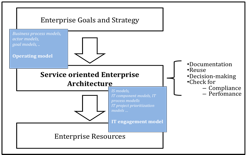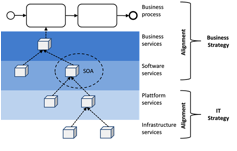There is a more and more common understanding, that not the ownership of information technology resources but their management is the foundation for sustainable competitive advantage [1]. According to Ross et al. [2], smart companies define how they (will) do business (using an operating model) and design the processes and infrastructure critical to their current and future operations (enterprise architecture), which guide the evolution of their foundation for execution. More and more companies would like their existing technology to enable their future capabilities. This capability to exploit the foundation, embedding new initiatives to make it stronger and using it as competitive weapon to develop new business opportunities, is estimated as 5% of companies [2].
Enterprise engineering is the application of engineering principles to the design, restructuring and operation of enterprises and their cooperation with other enterprises. It allows deriving the Enterprise Architecture from the enterprise goals and strategy and aligning it with the enterprise resources as shown in Figure 1. Enterprise architecture [2], [3] aims (i) to understand the interactions and all kind of articulations between business and information technology, (ii) to define how to align business components and IT components, as well as business strategy and IT strategy, and more particularly (iii) to develop and support a common understanding and sharing of those purposes of interest. Enterprise architecture is used to map the enterprise goal and strategy to the enterprise’s resources (actors, assets, IT supports) and to take into account the evolution of this mapping. It also provides documentation on the assignment of enterprise resources to the enterprise goals and strategy. To this end, advantageous patterns (best practices) can be reused and alternative design solutions can be compared. Furthermore, enterprise architecture may be checked for compliance with laws, regulatory rules etc. Finally, enterprise architecture facilitates the measurement the performance and efficiency of the resources used.
Service is the most important paradigm for the organisation of enterprises and the cooperation with other enterprises in order to achieve competitive advantage. Therefore it does not surprise, that leading enterprises in the U.S. derive more than 50% of their revenues from services [4]. Through services, enterprises stabilize their revenues [5]. This applies not only to pure services such as transportation but also for material products that are augmented by services such as maintenance, consulting and training. By exchanging services within partnerships, enterprises are able to combine their competences and thus provide solutions to the customer not possible for the single enterprise. Moreover meta-services (services acting upon other services) highly reduce the administrative overhead of enterprise services by encapsulating administrative functionalities as a service.
Furthermore, due to the technical advancements, e.g. Software as a Service, Cloud Computing and Service-Oriented-Architectures for information systems (SOA), enterprises are able to apply service-orientation to new areas. Service-oriented enterprise engineering further develops the enterprise engineering approach selecting service as governing paradigm. The enterprise goals and strategies are mapped to a service-oriented enterprise architecture, as shown in Figure 2.

|

|
Figure 1: Service-oriented Enterprise Engineering |
Figure 2: Service-oriented Enterprise Architecture |
Service-oriented enterprise architecture differentiates four layers of services, as shown above. Thus, its scope is much broader than the scope of the service-oriented architecture (SOA) and also includes services not accessible through software such as business and infrastructure services. Services of different layers may be interconnected in service (value) nets to provide higher level services.
- Business services are services, which directly support business processes. Business processes can also be developed dynamically (on-the-fly) using business services which are available in a repository for a given business domain. An example is call-centre services provided by an external service provider.
- Software services exist as two types: (i) human-oriented applications, which are provided as Software as a Service, (ii) application services which are part of so-called Service-Oriented-Architectures [6] that are a popular paradigm for creating enterprise software [7].
- Platform Services provide support of the development of applications. They provide services for the execution of applications, middleware stacks, web servers etc.
- Infrastructure services are more hardware-flavoured services, which are provided using computers. They may have a human addressee but contain many infrastructure services such as providing computing power, storage etc. They are an important topic in management and practice collections such as ITILV3 [8] or standards such as ISO/IEC 20000 have gained a high popularity.
[1]F.J. Mata, W.L. Fuerst, und J.B. Barney, “Information Technology and Sustained Competitive Advantage: A Resource-Based Analysis,” MIS Quarterly, vol. 19, Dec. 1995, S. 487-505.
[2] J.W. Ross, P. Weill, und D. Robertson, Enterprise Architecture as Strategy: Creating a Foundation for Business Execution, Harvard Business School Press, 2006.
[3] A. Wegmann, “Systemic Enterprise Architecture Methodology (SEAM)”). Published at the International Conference on Enterprise Information Systems 2003 (ICEIS 2003, Citeseer, 2003, S. 483-490.
[4] G. Allmendinger und R. Lombreglia, “Four strategies for the age of smart services,” Harvard business review, vol. 83, Okt. 2005, S. 131-4, 136, 138 passim..
[5] M.A. Cusumano, The business of software, Free Press..
[6] M.P. Papazoglou und W. Heuvel, “Service oriented architectures: approaches, technologies and research issues,” The VLDB Journal, vol. 16, 2007, S. 389-415.
[7]OASIS, “Reference Model for Service Oriented Architecture 1.0,” Aug. 2006..
[8]Ogc, Itil Lifecycle Publication Suite, Version 3:Continual Service Improvement, Service Operation, Service Strategy, Service Transition, Service Design: Service ... Operation AND Continual Service Improvement, Stationery Office Books, 2007.
|

